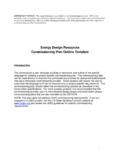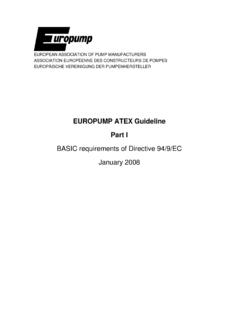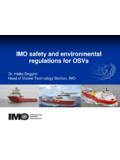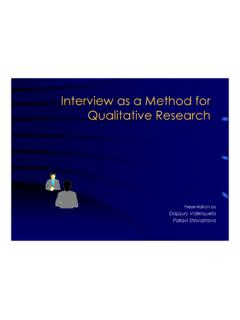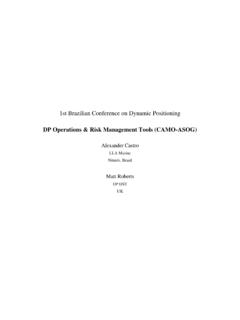Transcription of DESIGN CONSIDERATIONS IN THE DEVELOPMENT …
1 DESIGN CONSIDERATIONS IN THE DEVELOPMENT OF A NEW. ACADEMIC PROGRAMME STRUCTURE. Ansu Erasmus1. 1. INTRODUCTION. This paper discusses the merging of higher education institutions in South Africa, but also covers some generic DESIGN CONSIDERATIONS . There are additional CONSIDERATIONS for merged institutions because of the merging partners' different approaches, philosophies and culture, which must be accommodated when designing a new programme structure. It discusses in particular some of the experiences of the Tshwane University of Technology (TUT), the result of a merger between three former technikons (Technikon Northern Gauteng, Technikon North West and Technikon Pretoria).
2 The vision, mission and philosophy of these merging institutions differed sufficiently to create a number of challenges during the process of designing a new programme structure for the TUT. The national documents that influenced and advocated for mergers provide a host of guidelines, but are silent on how the programmes should be structured after the mergers (Mfusi, 2004: 109). And yet the vehicle for achieving higher education transformation goals is the academic programme. Jansen (2004: 5) observes that the curriculum is often treated as secondary to the larger financial and organisational alterations resulting from mergers' and there are few (if any) systematic studies on the curriculum effects of merging two or more higher education institutions'.
3 This paper discusses DESIGN CONSIDERATIONS in developing a new programme structure for merged institutions from two perspectives: broadly conceptual (Section 2) and institutional (Section 3). Although academic programme restructuring must of necessity be positioned in the international and national higher education context, this paper refers explicitly to such legislative and policy directives only when these have particular relevance to the discussion. 2. CONCEPTUAL FRAMEWORK. Defining the concepts This section unpacks the academic programme DESIGN terminology used in this paper, so as to ensure a common understanding.
4 1. Professor Ansu Erasmus is Director of Curriculum DEVELOPMENT and Support at the Tshwane University of Technology (TUT). Definitions of curriculum range from narrow interpretations to broad, all-encompassing statements which include almost every aspect of the full education system (SAQA, 2000: 5). According to Gravett & Geyser (2004: 147), the term refers to the entire range of educational practices or learning experiences: it could mean the total provision of a particular institution, it could also refer to a programme, as well as to a module or a single lecture or learning experience'.
5 In essence, a curriculum provides a systematic plan for teaching and learning to achieve specified learning outcomes. Curriculum DESIGN is a basic frame of reference or template for planning a curriculum which enables the organisation of its components or elements, noting the relationships that exist among its components. The term refers to the way we conceptualise the curriculum and arrange its major components (subject matter or content, instructional methods and materials, learner experiences or activities) to provide direction and guidance as we develop the curriculum' (Ornstein & Hunkins, 2004: 16).
6 The term curriculum DEVELOPMENT refers to the technical aspects of curriculum, how curriculum evolves or is planned, implemented, evaluated, as well as what various people, processes and procedures are involved in constructing the curriculum' (Ornstein & Hunkins, 2004: 16). A programme is a purposeful and structured set of learning experiences that leads to a qualification (CHE, 2004a: 25). It is a package consisting of a curriculum, learning resources, academic expertise and administrative support. In discussing academic programme restructuring, this paper considers this total package.
7 A qualification is the formal recognition and certification of learning achievement awarded by an accredited institution. Curriculum organisation Curriculum is organised in two ways, horizontal and vertical. These are not mutually exclusive: there is a continuum running from the one to the other. Horizontal organisation emphasises scope and integration and side-by-side arrangement of curriculum elements (Ornstein & Hunkins, 2004: 240). It takes a programmes based approach and is used particularly by universities of technology (UoTs). Vertical organisation, on the other hand, emphasises sequence and continuity and longitudinal placement of curriculum elements ( a spiral curriculum) and is typically used by discipline based traditional universities.
8 In the new institutions (comprehensive universities) that have resulted from the merging of a university of technology with a traditional university, the organisational DESIGN element is particularly significant for the articulation between the two types of programmes. In mergers of former technikons, however, the challenge is to agree on a position on the continuum for the programme designs in the new institution. In the case of the TUT, two years after the merger, academics are still debating the most appropriate DESIGN . Compounding the problem is the failure of some academics to understand the 2.
9 Need to align future programmes with the institution's mission statement and, more importantly, with the proposed HEQF (Higher Education Qualifications Framework . DoE, 2004b). The next section discusses several important curriculum DESIGN dimensions. Curriculum DESIGN dimensions In addition to the organisational elements of curriculum DESIGN , Ornstein and Hunkins (2004: 241 5) identify six DESIGN dimensions: Scope: the breadth and depth of content, topics, learning experiences and cognitive and affective learning (horizontal organisation of curriculum elements). Sequence: cumulative and continuous learning (vertical organisation of curriculum elements).
10 Continuity: the vertical manipulation or repetition of curriculum components, as in a spiral curriculum. Integration: the linking of all types of knowledge and experiences contained in the curriculum in an integrated manner. Articulation: the interrelatedness of various aspects of the curriculum vertically and horizontally. Balance: the appropriate weight given to each aspect of the curriculum DESIGN . Other dimensions can be added, depending on an overarching (national) educational philosophy and the particular educational approach that an institution/faculty/department chooses to adopt.










